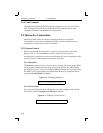
Incoming Connections Using the MSS
5 - 2
5.1.1.1 TCP/IP Socket Connections
The MSS supports TCP/IP socket connections to ports 2001 and 3001.
Opening a TCP session to port 3001 will form a raw TCP/IP connection to the
serial port. Port 2001 can be used when Telnet IAC interpretation is needed.
To specify a connection to a socket, use the Telnet command followed by the
MSS IP address (or resolvable name) and the desired socket number.
Figure 5-1: TCP/IP Socket Connection
5.1.1.2 IPX/SPX Socket Connections
The MSS supports SPX socket connections to port 9001. To make a socket
connection, use the SPX command followed by the SAP name of the MSS.
Figure 5-2: SPX Socket Connection
5.1.2 LAT Connections
Most VMS applications require the creation of a LAT application port to
access the MSS serial port. Programs can use the LAT application port as they
would use a physical port for input and output. For example, an application
might be conÞgured to use port LTA3419 which would allow it to access a
device connected to the MSS serial port.
To conÞgure LAT on your VMS host, create a new and unique application
port using the hostÕs LATCP program (in Figure 5-3, LTAnnnn represents any
unused LAT port number). Map the application port to the MSS by specifying
the MSS node name and the serial port name. Enter the following commands
at the VMS prompt:
Figure 5-3: Creating a LAT Application Port
% TELNET mymss:2001
Local> SPX MSS_xxxxxx_S1
$ RUN SYS$SYSTEM:LATCP
LCP> CREATE PORT LTA
nnnn
/APPLICATION
LCP> SET PORT LTA
nnnn
/node=
mssname
/port=port_1
LCP> SHOW PORT LTA
nnnn
LCP> EXIT


















